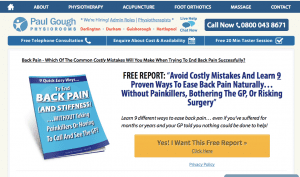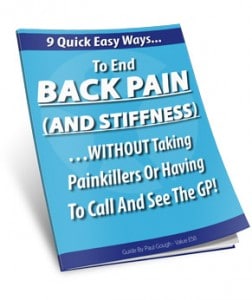If you’re frustrated by the number (or lack of) self referrals happening from your website, then this article is perfect for you:
So, just about every independent “pt” clinic owner I speak to, tells me something like this:
“I know I need to do something about my website – I just don’t know where to begin”
If that’s you too, then let me help you out with 3 tips to improve your website and explain why designing a website to boost self-referrals – should follow the rules of “going out on a first date!”
Tip 1.) Make Regular changes To Your Site And NOT Just One Big, Complete Overhaul
It’s tempting to think that the best thing to do is just start the whole thing again, but most times it’s better to test what’s working and what isn’t on your current site before you build a new one from scratch.
Now, if you’re getting NOTHING in the way of anyone mentioning having found you on Google searches – or commenting on how helpful your website was in the decision making and self-referral process (the ONLY reason for having a website) – then I agree, it maybe time for a big change… as a website that isn’t working for you to deliver self-referrals is actually costing you a lot of money and would be worth spending some $$$ on!
But where most clinic owners go wrong is this:
They think they have to build a website from scratch – which usually takes months (and is painstakingly difficult and expensive to complete), then, when it’s FINALLY created, realise not much has changed in the way of getting more self-referrals.
And what’s more, by the time the new website is finished, there’s always the temptation to think it’s still not good enough – made worse when you take a look at someone else’s website that you like better and decide that yours is now “out of date”, or needs more work.
So they start planning ANOTHER website rebuild.
And yet all they change is the “colours”, or the fonts and add a few more pretty pictures to make it look like one they “like” and “think” works.
But, that’s not the best way to do.
No, you’re much better off making small, but very regular changes to your website after TESTING what is working and finding out what isn’t – such as your “enquiry forms” or pages that you’re asking for patients to do take action, such as “contact us”.
Use something like “Optimizely” (which I use) or “Visual Website Optimiser”, to do this and even track the number of phone calls you get from EACH PAGE of your website, using “call tracking metrics” which is the software I use to track it from my own website.
Tip 2.) Turn To “Direct Response” Style Pages
There’s essentially two different types of websites you could chose from.
One is known as a “brochure site” (…that most web designers will want to build and try to charge you a LOT of $$$), then there’s another other (which actually makes some money and costs a let less) and is called a “Direct Response” style website.
Now, most pt website’s I’ve been asked to critique are “brochure sites”.
Nothing wrong with that – UNLESS it’s bringing in referrals everyday like clockwork.
(But I suspect, most don’t).
See, the problem with brochure websites is that the OWNER judges his or her website by how nice they look – and is often guided by a web designer who is CLUELESS (respectfully) about direct response marketing – or leaves it to another company who designs their website just the same as everyone else who uses their templates too.
And the re-design project is considered a success based upon “subjective” things – like “whitespace”, “feel”, how many pretty pictures are up there and even on what it says about the company and the owner of the business on the home page (…as opposed to testing).
But non of that is going to influence visitors/new patients on your site to take action.
Why?
Well, let me explain it to you with an analogy from the “dating” world:
Think about going on a first date with a girl or guy you’ve just met…
Would you “ask for marriage” when you first hook up?
Course not!
Well, asking people who have JUST arrived on your pt website to “book an appointment” with you is a lot like talking about “marriage” (or having kids) on a first date.
Sure, he or she may look BEAUTIFUL (…just like many pt websites do) – but it’s just too big of a leap for anyone to say “yes” on that first date to marriage!
In fact, you’d scare them off so much that they’d never come back.
And the same thing is likely happening the first time someone lands on your website if all you do is give them the option to “book an appointment”.
It would be much more likely to lead to a life long and lasting relationship with that patient if you offer to get to know him or her first…
And besides, when it comes to websites (and not date nights!!) it’s often true that “ugly” work best – so there’s no need for expensive web design costs anyway.
Websites with compelling, emotive copy and REAL reasons to respond are much more profitable – even if they’re a little “ugly”.
So that’s one problem…
And the second biggest problem I see with brochure style websites is this:
They’re all about the clinic and the clinic owner or staff.
And NOT what the clinic can do or who it helps – which is what the visitor is really looking for.
Back to our dating analogy.
How long would the date last (or would you get another one?) if all you spoke about on your first date was “YOU”?
Unlikely!
Now, contrast that with a “Direct Response” style website, and you’ll find that it’s ALL about the VISITOR and what the clinic can do to help them.
(Big difference, massive difference).
Even the “ABOUT” page should be written in a way that shows “WHO” the clinic helps and should start with “We Help…” and NOT, “We Are…”, like most do!
Same with the staff profiles: Instead of listing qualifications and hobbies and interests of the pt’s you employ, why not use this area to say “he helps people with….”, or “he is the pt you should choose if you have back pain”… etc etc etc.
Even just doing that is much more likely to bring the person looking on your site closer to you – and more like to book an appointment. What you’re doing here is magnetically attracting people towards you based on what you can do to help them, not shouting out at them about who you are and how good you are.
For an example of a very profitable direct response website, please click here:
It’s my own clinics website – there’s lots of testing gone into the pages and buttons and is based upon everything that I learned while studying studying “Direct Response” marketing techniques.
Now, what you’ll see is that on every single page, there’s a compelling reason for the visitor to RESPOND or take action – and not always just to “book an appointment”.
Sometimes it’s the simple things that make the difference, too:
For an example, look at the website and see how I use the words “ENQUIRE” (and not “BOOK”).
That’s because there’s much LESS commitment to enquire about my services, than to book!
I’m not saying “arrange a date with me”…
By using the word “enquire” I’m giving the visitor the option to find out more about me BEFORE they decide they would like me to take them to the movies or out for a meal!
Tip 3.) Begin A Relationship By Offering Something Valuable In Exchange For Contact Details (And Follow Up)
And what you’ll notice about my site is that I’m NOT just asking the person to call me off the back of reading a glowing reference (written by me) saying how good I am, how long I’ve been in business, or, that I pride my self on great customer service and am “highly qualified”.
(Like almost EVERY website does!)
I’m all of that – but would you go for dinner with someone after ONLY seeing their profile on a dating site – the one that everyone knows is written by them?
Of course not!
But if you’re kind of interested, you’re going to have a few back and forth style emails or SMS messages to see if what they say about them selves seems to be true, and IS what you’re looking for – before you commit to the date night!
It should be the same “low risk” process on your website.
Saying how professional you are, or how many qualifications you’ve got etc etc etc, those types of lines are not going to motivate anyone to book an appointment with you.
(And besides – all your competitors are saying the same thing and have the same qualifications anyway)
The reality is they’re the base line of what people expect these days – so to shout about it, well, it isn’t really going to give you an edge!
It’s much better to use your website to “begin a relationship with a visitor”.
Back to “dating”:
If you meet someone in a bar or online, chances are you’ll offer them your number or email address BEFORE you ask for the date.
Same with your website.
Offer visitors something valuable like a “free tips report” (something that looks like this):
…And which you’re happy to give away in exchange for their contact details.
Why?
So that you can then follow up and explain multiple times over (using emails, direct mail or on the phone…) all about your pt clinic and how easy it is to self-refer – which is of course, the number 1 end goal of having a website in the first place.
For an example on how to do that on a pt website (not to pick up dates! lol), go here:
www.paulgoughphysio.com/back-pain
And see how I offer to HELP my new visitor (with back pain) before I ask them for money by booking an appointment.
Of course, on there, I leave a little message saying something like “if your need is urgent, please click here” which alerts the small number of visitors whose need is urgent to the fact that they can book an appointment, if they’re in a lot of pain and ready to book now.
(I do have dating analogy for that – but best not bring it up, lol)!!
The fact is, 99% of the people who visit your website are NOT ready to book now.
They’re NOT ready to commit to marriage.
They’re just looking for information and want to get to know you a little better.
Design your website so that you can give it to people and preferably in exchange for contact details so that you can have repeated attempts at getting your message across.
Do that, and you’ll soon see that “self-referrals” from your website will go off the scale as people realise that they like you and trust you for offering to help them FIRST. Often that alone is enough to get you noticed above everyone else in town who is immediately asking for the sale – from someone who hardly even knows of them.
Click Here To Get Regular Tips To Make Your PT Website More Profitable >>>
Paul Gough
Author, Clinic Owner, Founder at PT Profit Academy
P.S For more website tips like this, come and join all the other pt’s in the USA on my email list: Click Here To Get Regular Tips To Make Your PT Website More Profitable >>>
- Violating Social Norms and Outdated Levels of Thinking - 22nd October 2020
- MORE from LESS: The Go To Strategy During A Financial Downturn (Like here in 2020) - 15th October 2020
- How To Confidently Sell Your Physical Therapy Services - 29th April 2020
- Telehealth: What Does The Future of PT Look Like? - 17th April 2020
- How To Get More Buy-In From Patients - 16th April 2020
- Telehealth: Have You Already Done It Without Realizing? - 16th April 2020
- Telehealth: What Is the Most Important Thing You Can Sell Right Now? - 15th April 2020
- Telehealth: Is A Marketing Funnel Needed Right Now? - 14th April 2020
- Telehealth: What Happens To Discovery Visits? - 13th April 2020
- Telehealth: How Will I Compete With “Big Box” Insurance Companies? - 10th April 2020
















